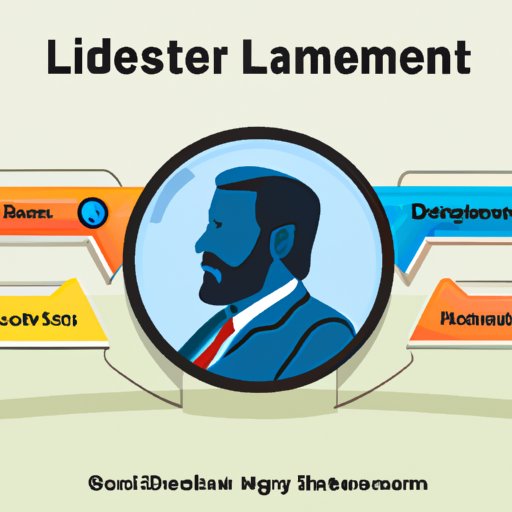Introduction
A leadership assessment is an evaluation of a leader’s performance, strengths, weaknesses and overall effectiveness. This type of assessment is designed to help organizations identify areas where leaders can improve their skills, as well as determine which individuals have the potential to become great leaders. The primary purpose of a leadership assessment is to provide a comprehensive understanding of how a leader’s characteristics affect the organization’s overall success.
Analyzing the Benefits of a Leadership Assessment
Leadership assessments are beneficial for both the individual and the organization. For the individual, they can provide insight into their strengths and weaknesses, as well as identify areas that require improvement. For the organization, these assessments can be used to evaluate the current leadership team and identify potential leaders who can help the company reach its goals.
The following are some of the key benefits of a leadership assessment:
Improved Performance
One of the main benefits of a leadership assessment is improved performance. By identifying the strengths and weaknesses of a leader, organizations can better understand how to use those strengths to their advantage and develop strategies to address any weaknesses. This allows organizations to increase the efficiency and effectiveness of their leaders, resulting in improved performance.
Increased Organizational Development
A leadership assessment can also be used to identify opportunities for organizational development. By assessing the current state of the organization, leaders can gain insight into areas where improvements can be made, such as communication, collaboration, and creativity. This can lead to increased innovation and productivity, as well as improved employee morale.
Enhanced Self-Awareness
Finally, leadership assessments can help individuals gain a better understanding of themselves. Through self-reflection and feedback from others, individuals can gain insight into their own strengths and weaknesses and develop a greater awareness of how their actions affect others. This can help them become better leaders and more effective at leading teams and organizations.

Exploring the Different Types of Leadership Assessments
There are several different types of leadership assessments available. Each type has its own unique benefits and focuses on different aspects of a leader’s performance. It is important to select the right type of assessment for your organization and its specific needs.
Personality Tests
Personality tests are one of the most popular types of leadership assessments. These assessments measure a leader’s traits and behaviors, such as their emotional intelligence, adaptability, and decision-making skills. The results of these tests can provide valuable insight into a leader’s strengths and weaknesses, allowing organizations to develop strategies to help them become better leaders.
360-Degree Feedback
360-degree feedback involves gathering input from multiple sources, including peers, subordinates, and supervisors. This type of assessment provides a comprehensive view of a leader’s performance and allows organizations to identify areas where improvement is needed. Additionally, it can help leaders gain insight into how others perceive their abilities and behavior.
Behavioral Interviews
Behavioral interviews involve asking questions about a leader’s past experiences, their approach to problem-solving, and their management style. This type of assessment can provide valuable insight into a leader’s ability to handle different situations, as well as how they interact with others. It can also help organizations identify potential issues before they arise.
Investigating the Impact of a Leadership Assessment on Performance
Leadership assessments can have a significant impact on a leader’s performance. By identifying a leader’s strengths and weaknesses, organizations can develop strategies to help them become better leaders. Additionally, assessments can help organizations understand how leaders can motivate others, evaluate problem solving skills, and identify areas where improvement is needed.
Ability to Identify Strengths and Weaknesses
A leadership assessment can provide valuable insight into a leader’s strengths and weaknesses. This information can then be used to develop strategies to address any areas of weakness and capitalize on any areas of strength. By doing this, organizations can ensure that their leaders are performing at their best.
Understanding How Leaders Can Motivate Others
Leadership assessments can also be used to evaluate a leader’s ability to motivate others. By understanding how a leader motivates their team, organizations can develop strategies to improve their motivation techniques and ensure that their team is working towards the same goals.
Evaluating Problem Solving Skills
Finally, a leadership assessment can be used to evaluate a leader’s problem solving skills. By understanding how a leader approaches problem solving, organizations can develop strategies to improve their problem solving techniques and ensure that their leaders are equipped to handle any issue that may arise.

Examining the Process of Completing a Leadership Assessment
Completing a leadership assessment is a multi-step process. The first step is preparation, which involves gathering the necessary information and materials, such as job descriptions and feedback forms. The second step is administration, which entails distributing the assessment to participants and collecting their responses. The final step is analysis, which involves interpreting the results and developing strategies based on the findings.

Evaluating the Role of a Leadership Assessment in Organizational Development
A leadership assessment can play an important role in organizational development. By providing insight into a leader’s strengths and weaknesses, organizations can identify areas where improvement is needed and develop strategies to enhance their leadership capabilities. Additionally, assessments can help organizations understand how leaders can motivate others, encourage collaboration, and foster creativity.
Conclusion
In summary, a leadership assessment is a valuable tool for organizations looking to improve their performance and develop their leaders. Through assessments, organizations can identify areas where improvement is needed, as well as evaluate a leader’s strengths and weaknesses. Additionally, assessments can help organizations understand how leaders can motivate others and foster creativity. Ultimately, a leadership assessment can be an invaluable resource for organizations looking to improve their performance and develop their leaders.
(Note: Is this article not meeting your expectations? Do you have knowledge or insights to share? Unlock new opportunities and expand your reach by joining our authors team. Click Registration to join us and share your expertise with our readers.)
